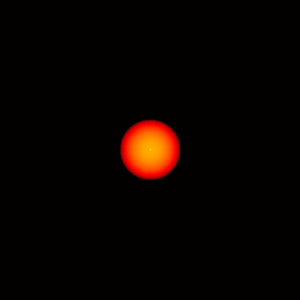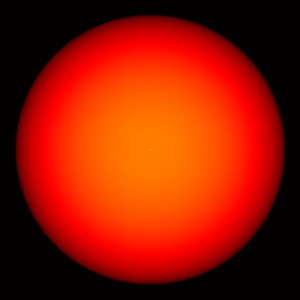



First, let's look at how a star with the mass of the Sun might evolve. The four figures below illustrate what this star will look like in the phases of its evolution. These figures are all to the same scale, which is approximately the diameter of the Earth's orbit from one side of each box to the other.
| The Main Sequence | The Red Giant Branch | The Horizontal Branch | The Asymptotic Giant Branch |
 |
 |
 |
 |
Eventually, the interior of a forming star gets so hot, thermo-nuclear fusion reactions begin in the core. These reactions produce tremendous amounts of energy, halting the collapse process and allowing the star to settle onto what is called the main sequence. Main sequence stars provide their energy by fusing hydrogen atoms together to produce helium.
The more massive a star is, the more energy it requires to counteract its own gravity. As a consequence, very massive stars burn the available hydrogen in their cores much more quickly than low-mass stars. The more massive a star is, the shorter its life on the main sequence will be. Stars with the mass of the Sun will last on the main sequence about 9 billion years. Very massive stars, like those in the Trapezium in Orion, will only last a million years or less. Low-mass stars can survive for tens of billions of years or more.
Stars more massive than the Sun not only burn out more quickly, but they burn much hotter and brighter. Less massive stars burn cooler and dimmer. Temperature translates to color, and this relationship between color and brightness (luminosity) for hydrogen-burning stars is called the main sequence. Massive hydrogen-burning stars are blue-white, the Sun is yellow, and low-mass stars are orange and red.
When all of the hydrogen in the core of a star has been converted to helium, there is nothing left to prevent the core from collapsing under its own gravity. Hydrogen to helium fusion continues in a shell around this core, but the core starts to contract. As it does this, the temperature of the core increases and the luminosity increases, in some cases by a factor of 1000 or more. This extra energy production will cause the outer layers of the star to expand, even while the core is collapsing. In this bizarre geometry, even though the interior temperature is far hotter than on the main sequence, the outer layers expand and cool, producing a red giant.
The horizontal branch is also called the helium-burning main sequence.
Eventually, the temperature of the stellar core gets so high, helium fusion can occur. The star has now found a new energy source to hold itself up, although it won't last anywhere near as long as the hydrogen-burning main sequence. The star contracts and dims as it settles down on the helium-burning main sequence.
When the star exhausts its supply of helium in the core, it repeats the process that sent it up the red giant branch. The core begins to contract and heat up again, and the envelope expands and reddens, getting even larger than before. When the Sun reaches this phase, its radius will extend past Earth's orbit. Not only will Earth be cooked, but it will actually be swallowed up by the Sun! The interior of a star on the asymptotic giant branch has several layers. Around the inert (but toasty) core, there's a thin shell of helium fusion. Around this an inert shell of helium (the temperature isn't high enough to allow helium fusion), and around this a layer where hydrogen fuses into helium.
This structure is not just complicated, it's also unstable to pulsations. While we don't know what drives the pulsations, we do know that once they start, they're hard to stop. These pulsations can actually be so strong, layers of the star will be blown off into space. Perhaps a star can lose half of its mass or more in this phase. As the mass expands into space, it cools and condenses out into dust grains. With enough mass-loss, a star will eventually be surrounded by a dust shell so thick that optical radiation is trapped. The shell reprocesses the radiation and emits it in the infrared. The star disappears from the visual sky and becomes an infrared source.
For more information on these dust shells, go to the circumstellar dust page.
Stars several times more massive than the Sun have a simpler, quicker, and more spectacular evolutionary sequence. When the core hydrogen runs out, the core contracts and the envelope expands like less massive stars, and the star gets much redder, but since it's so much brighter and so much bigger, it becomes a red supergiant. One supergiant, Betelgeuse, is several times the size of Earth's orbit around the Sun, bug enough to swallow Jupiter.
Because supergiants are so massive, the core temperature gets much hotter than in giants, so supergiants can fuse elements heavier than hydrogen and helium. But to support their tremendous mass, supergiants burn up their fuel much more quickly. Eventually, all possible fuels are exhausted, the core collapses, and the star goes supernova.
To continue the story, read about the death of stars.
Last modified 11 January, 2021. © Gregory C. Sloan.